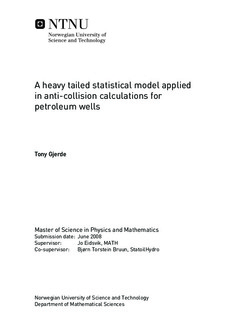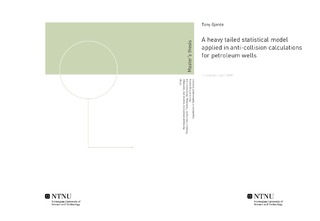| dc.contributor.advisor | Eidsvik, Jo | nb_NO |
| dc.contributor.advisor | Bruun, Bjørn Torstein | nb_NO |
| dc.contributor.author | Gjerde, Tony | nb_NO |
| dc.date.accessioned | 2014-12-19T13:57:57Z | |
| dc.date.available | 2014-12-19T13:57:57Z | |
| dc.date.created | 2010-09-04 | nb_NO |
| dc.date.issued | 2008 | nb_NO |
| dc.identifier | 348618 | nb_NO |
| dc.identifier | ntnudaim:4021 | nb_NO |
| dc.identifier.uri | http://hdl.handle.net/11250/258427 | |
| dc.description.abstract | Anti-collision calculations are done during the planning of a new petroleum well. These calculations are required in order to control the risk of having a well-collision, which is an unwanted event at any cost. The risk of having a well-collision is closely related to the position uncertainty both of the well that is planned and of the existing wells in the given region. Earlier literature has indicated that the distribution of the position errors are more heavy-tailed than a normal distribution, which leads to the question whether the current methods are accurate enough. The currently used industry standard calculates the standard deviation of the centre to centre distance by an approximation, and assumes that the centre to centre distance is normally distributed. In this thesis we use a heavy-tailed Normal Inverse Gaussian (NIG) distribution for the declination error source in MWD magnetic directional surveying, which lead to a position uncertainty that is heavy-tailed relative to the multivariate normal distribution. The parameters of the NIG-distribution are estimated from processed magnetic field data from the Tromsø geomagnetic observation station. The NIG-distribution requires the use of Monte Carlo simulations in order to apply the currently used industry approach. Other error sources are also included in the error model to give a more realistic position uncertainty. Three different anti-collision cases demonstrate the differences in using the NIG error model and the normal error model. We compare the simulation based results against the currently used methodology. The results are very dependent on the well geometries. The results differ significantly, and the NIG error model is the most conservative distribution in most cases, with respect to whether a wellplan should be realized or not. However, there are cases where a normally distributed declination error gives more conservative decisions than the NIG-distribution. As an alternative to change the distribution of the declination error, we propose two corrective actions to improve the existing anti-collision methodology. One action is to exchange one of the approximations in the current methodology with simulations or analytical computations. The other action is to correct for bias in the expected position, which is caused by the NIG error model. | nb_NO |
| dc.language | eng | nb_NO |
| dc.publisher | Institutt for matematiske fag | nb_NO |
| dc.subject | ntnudaim | no_NO |
| dc.subject | SIF3 fysikk og matematikk | no_NO |
| dc.subject | Industriell matematikk | no_NO |
| dc.title | A heavy tailed statistical model applied in anti-collision calculations for petroleum wells | nb_NO |
| dc.type | Master thesis | nb_NO |
| dc.source.pagenumber | 113 | nb_NO |
| dc.contributor.department | Norges teknisk-naturvitenskapelige universitet, Fakultet for informasjonsteknologi, matematikk og elektroteknikk, Institutt for matematiske fag | nb_NO |

